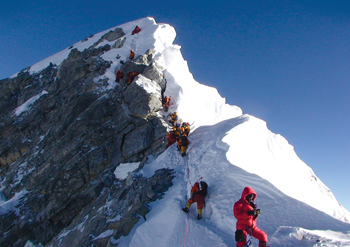
WOODLAND BLOG
When Edmund Hillary and Tenzing Norgay climbed Mt Everest 60 years ago, the summit ridge used to be almost entirely snow and ice. The Khumbu Glacier used to be much longer and thicker than it is today.
The vertical section on the South-east Ridge just below the summit called the Hillary Step (pictured) represented the last obstacle for mountaineers before they got to the top. But as the Earth warmed up due to climate change in the last 60 years, the Hillary Step today is mostly crumbling rock.
“The Hillary Step and the traverse to it from the South Summit were almost entirely snow climbs with very little exposed rock,” says David Breashears, American climber and filmmaker. “Now our crampons scrape and scratch across hundreds of feet of exposed rock and the snow arête that Hillary climbed no longer exists.”
Breashears, who has been documenting the effect of climate change on the Himalayan permafrost through before and after pictures, says he has seen changes even during the five times that he has climbed Everest. (read the interview here).
As Nepal marks the 60th anniversary of the first ascent of Mt Everest, and making it to the summit becomes almost routine, the thrill of exploration has turned to worry about what we are doing to the planet. As with the Arctic Ice Cap and Greenland, the Third Pole (as the Himalaya is known) is also melting dramatically.
This year’s spring climbing season on Mt Everest has witnessed even more records being broken. The first Saudi and Pakistani woman to get to the top, the first Arab Sheikh on the summit, the first person with no hands to climb, the first Nepali actress on top, and even the highest ever brawl in the world.
However, the real record is the record melting on the flanks of the world’s highest mountain. By all accounts, the melting ice has exposed rock outcrops making climbs more dangerous. It has also made it more scary as the corpses of dead climbers emerge from the thawing ice. In the spring of 2011, Apa Sherpa set foot on the summit of Mt Everest for the 21st time breaking his own record. He says: “In the years from my first ascent in 1990, I have seen the snow cover melting. Where there used to be ice slopes, there is now only rocks.”
Earlier this month, carbon dioxide concentration in the atmosphere hit the highest level in 4 million years at 400 parts per million (ppm). A new study has shown that the glaciers that come down from Mt Everest have lost 13 per cent of their ice in the last 50 years.
Historically, during the age of first ascents in the 1950s, climbers preferred the spring on eight thousanders because the temperatures were higher and there would be less wind. But as climbing gear and clothing improved, many mountaineers switched to the less-crowded autumn season despite the jet stream’s hurricane-force winds on the summit. Now, because of the shift in monsoonal patterns it seems climbers prefer spring again.
Apa Sherpa who retired from climbing in 2011 is worried about climbers who will now have to make the trip to the top amid unstable weather along a rocky path. “There are more frequent avalanches, more crevasses and exposed rock faces where there used to be snowfields,” says Apa.
The accelerated melting in the mountain is exposing all kinds of mountaineering debris: oxygen tanks, clothing, tents and even human remains. Asian Trekking in Kathmandu began initiatives in 2008 to deal with the trash. Ang Tshering Sherpa, chairman of Asian Trekking who made it only till 8,000 meter in 1977 says, “Despite better equipment and technically sound climbers, the unpredictable weather now changes the game at the top.”
Although the ice in the Himalaya is a source of major rivers in Asia and about 1.5 billion people depend on it, there have been very few comprehensive studies carried to understand how climate change will ultimately affect the water stored in the mountains as ice.
Read also:
The State of the Himalaya
Is climate change changing climbing?
Climbing to keep the Himalaya alive